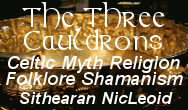Ariadne's Tribe: Minoan Spirituality for the Modern World
Walk the sacred labyrinth with Ariadne, the Minotaur, the Great Mothers, Dionysus, and the rest of the Minoan family of deities. Ariadne's Tribe is an independent spiritual tradition that brings the deities of the ancient Minoans alive in the modern world. We're a revivalist tradition, not a reconstructionist one. We rely heavily on shared gnosis and the practical realities of Paganism in the modern world. Ariadne's thread reaches across the millennia to connect us with the divine. Will you follow where it leads?
Find out all about Ariadne's Tribe at ariadnestribe.com. We're an inclusive, welcoming tradition, open to all who share our love for the Minoan deities and respect for our fellow human beings.
The Seasons of the Minoan Calendar
In Ariadne's Tribe, we developed our sacred calendar one bit at a time over the course of several years, relying on a combination of archaeology, comparative mythology, dance ethnology, and shared gnosis to collect up and organize the festivals. But now that it's a living, functioning thing that we've worked in sync with for a while, something interesting has happened.
We've come to know the seasons of ancient Crete.
There appear to have been three distinct cultural groups in Bronze Age Crete: farmers, sailors, and goat-herders. All three originated in Neolithic Anatolia and migrated down to Crete in multiple waves around 10,000-9,000 BCE. Each group had their own calendar based on the yearly cycle of their activities. But interestingly, the three calendars look like they overlap a great deal.
The basics: there were three seasons. We call them Summer, Winter, and the Blooming Time.
In a Mediterranean climate area like Crete, the summer is the "dead time" - it's the dry season. No rain, incredible heat, and everything turns crispy brown. The winter is the rainy season, when everything turns green and grows.
So how do the three calendars work together? Let's start with Summer.
The beginning of Summer marked the start of the sailing season for the folks who went to sea to make a living. For farmers who grew field crops like grain and vegetables, it was the fallow season. The fields lay bare since it was too hot and dry for anything to grow, and the ground was too dry and hard to plow. For herders, it was the time to take their herds up to the summer pastures high in the mountains, where the springs and snowmelt-fed streams still supported some fresh green growth that the animals could eat.
As summer ended and the rainy season began, everyone's lives shifted into Winter season mode. The farmers rejoiced when the autumn rain softened the ground enough that they could plow the soil and plant their crops. For them, Winter was the growing season (still is throughout the Mediterranean, actually, but we're talking about the Bronze Age right now). For the sailors, this time of year heralded a change in the winds, making it no longer safe to put to sea. So they returned home to enjoy a season of rest. And the herders brought their goats down from the mountains to the freshly green lowlands where they could enjoy lush grazing all season long.
The seasons I've just talked about - Summer and Winter - were long. Each one took up nearly half the year. Though the exact dates varied among the different subcultures and from year to year, generally speaking, Summer lasted from May through September or October. And Winter lasted from October to February or early March.
That leaves a small portion of the year, the "short season" of March and April. We call it the Blooming Time, because even though flowers of one sort or another bloom at various times of the year on Crete, huge swaths of blooming wildflowers in the lowlands and hills of Crete are a major feature of this short season. This profusion of color lends power and emotion to the Blooming Time and helps underscore it as a season in which life and death combine.
The Blooming Time was a busy season in ancient Crete. The sailing people spent that time preparing their ships to sail: making repairs and planning out their Summer travel. The farmers harvested their grain crops - wheat and barley and possibly rye - during this season. And the herders had the difficult task of culling their herds, since the high summer pastures weren't as lush as the lowland winter pastures.
So the Blooming Time was a season of life and death, of vigorous spring growth as well as harvest and slaughter. It was a concentrated, focused pivot on which the larger seasons of Summer and Winter hinged.
The Blooming Time is coming up soon. What will you harvest or cull and how will you prepare for the larger part of the year?
Comments
-
Please login first in order for you to submit comments




















